Managing Innovation Report: Innovation Theories and TerraCycle
VerifiedAdded on 2022/08/29
|22
|4782
|19
Report
AI Summary
This report examines TerraCycle's approach to innovation, specifically focusing on the closed-loop innovation theory. It defines the theory's principles and processes, evaluating its benefits and limitations. The report then applies this theory to TerraCycle's historical development, including a background of the company. The analysis covers the evolution of its products and services within the context of closed-loop principles. Furthermore, the report proposes potential future development pathways for TerraCycle's products and services based on the closed-loop innovation theory. The report also provides a detailed executive summary and table of contents, enhancing its structure and clarity. References and an appendix containing relevant figures and data are also included.
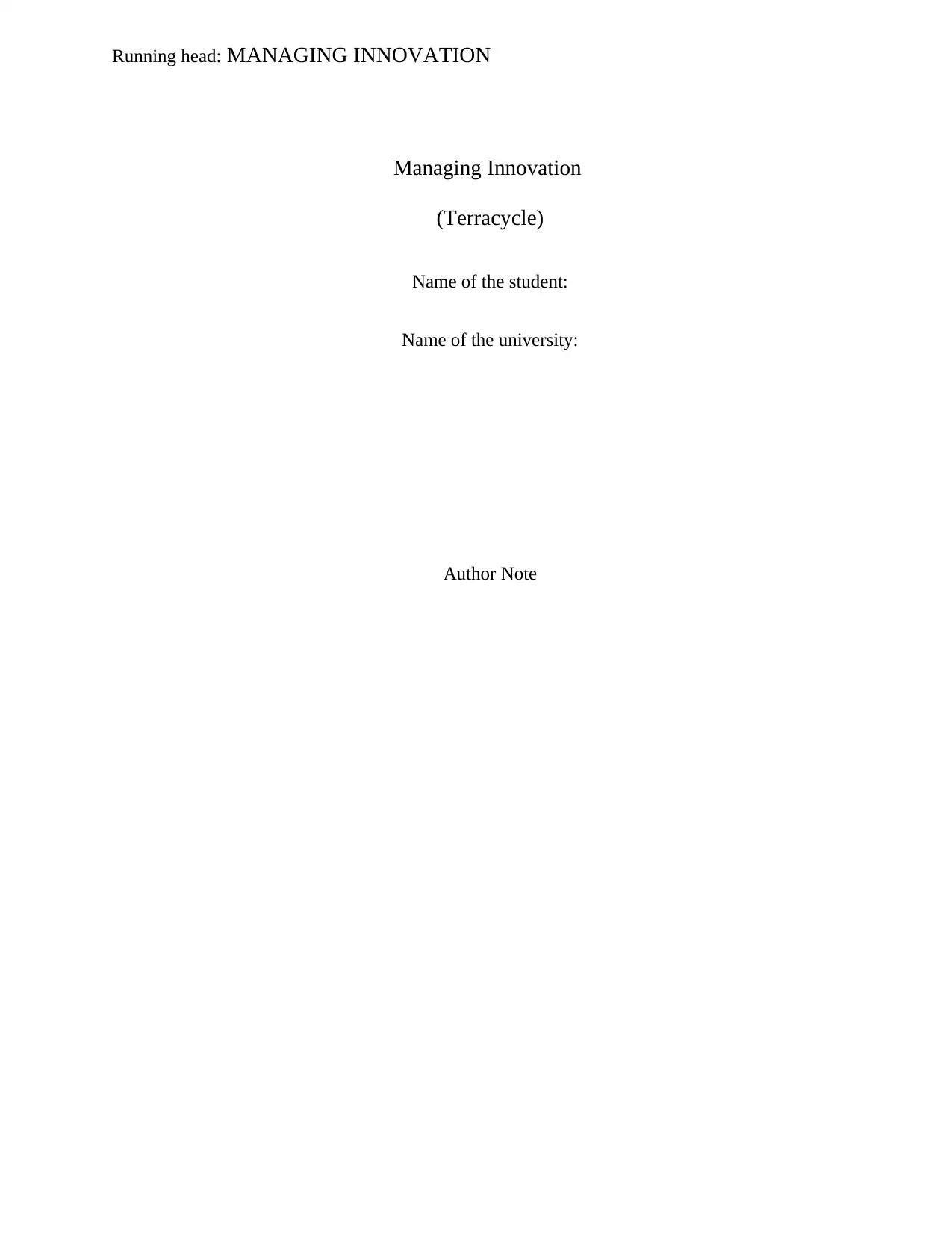
Running head: MANAGING INNOVATION
Managing Innovation
(Terracycle)
Name of the student:
Name of the university:
Author Note
Managing Innovation
(Terracycle)
Name of the student:
Name of the university:
Author Note
Paraphrase This Document
Need a fresh take? Get an instant paraphrase of this document with our AI Paraphraser
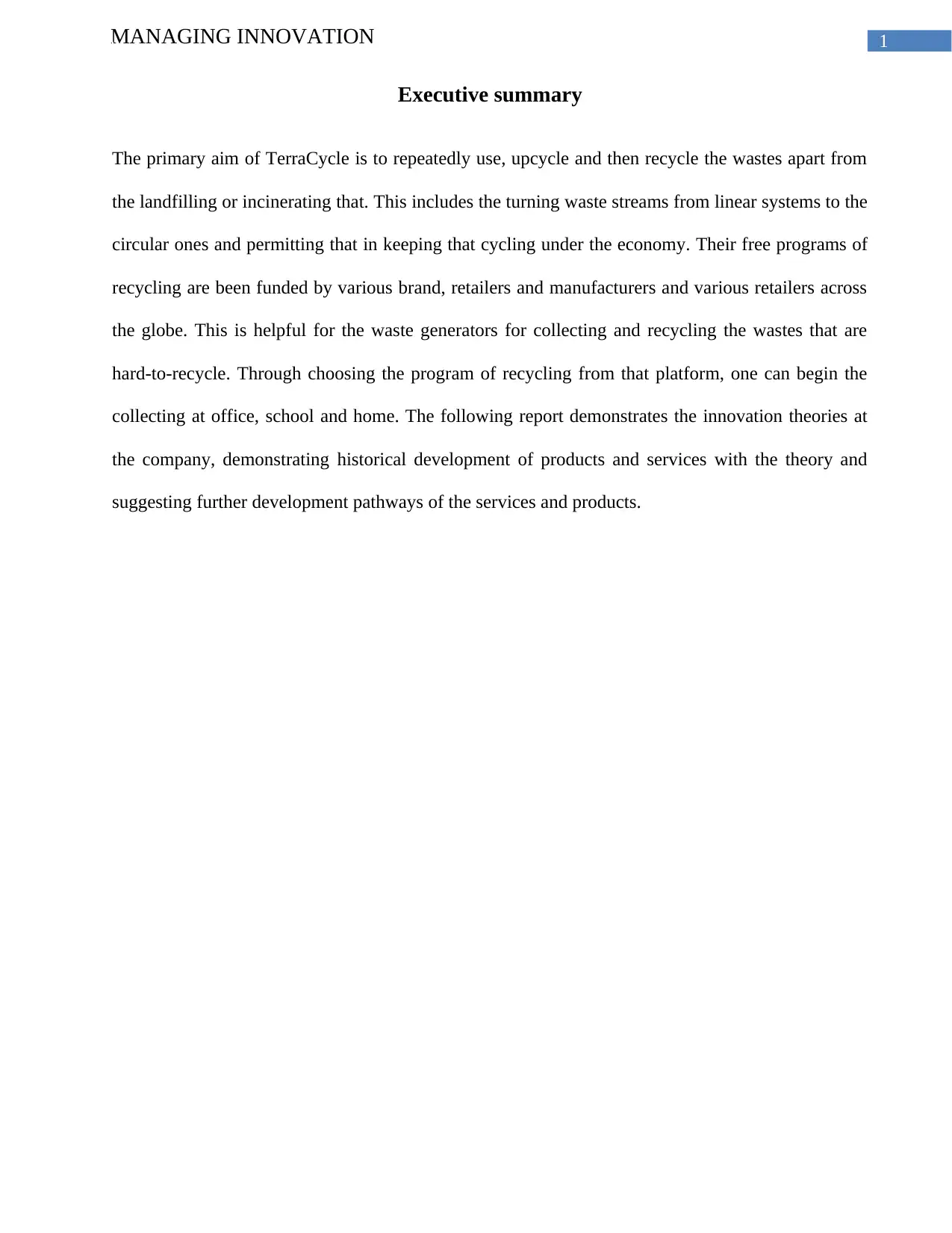
1MANAGING INNOVATION
Executive summary
The primary aim of TerraCycle is to repeatedly use, upcycle and then recycle the wastes apart from
the landfilling or incinerating that. This includes the turning waste streams from linear systems to the
circular ones and permitting that in keeping that cycling under the economy. Their free programs of
recycling are been funded by various brand, retailers and manufacturers and various retailers across
the globe. This is helpful for the waste generators for collecting and recycling the wastes that are
hard-to-recycle. Through choosing the program of recycling from that platform, one can begin the
collecting at office, school and home. The following report demonstrates the innovation theories at
the company, demonstrating historical development of products and services with the theory and
suggesting further development pathways of the services and products.
Executive summary
The primary aim of TerraCycle is to repeatedly use, upcycle and then recycle the wastes apart from
the landfilling or incinerating that. This includes the turning waste streams from linear systems to the
circular ones and permitting that in keeping that cycling under the economy. Their free programs of
recycling are been funded by various brand, retailers and manufacturers and various retailers across
the globe. This is helpful for the waste generators for collecting and recycling the wastes that are
hard-to-recycle. Through choosing the program of recycling from that platform, one can begin the
collecting at office, school and home. The following report demonstrates the innovation theories at
the company, demonstrating historical development of products and services with the theory and
suggesting further development pathways of the services and products.
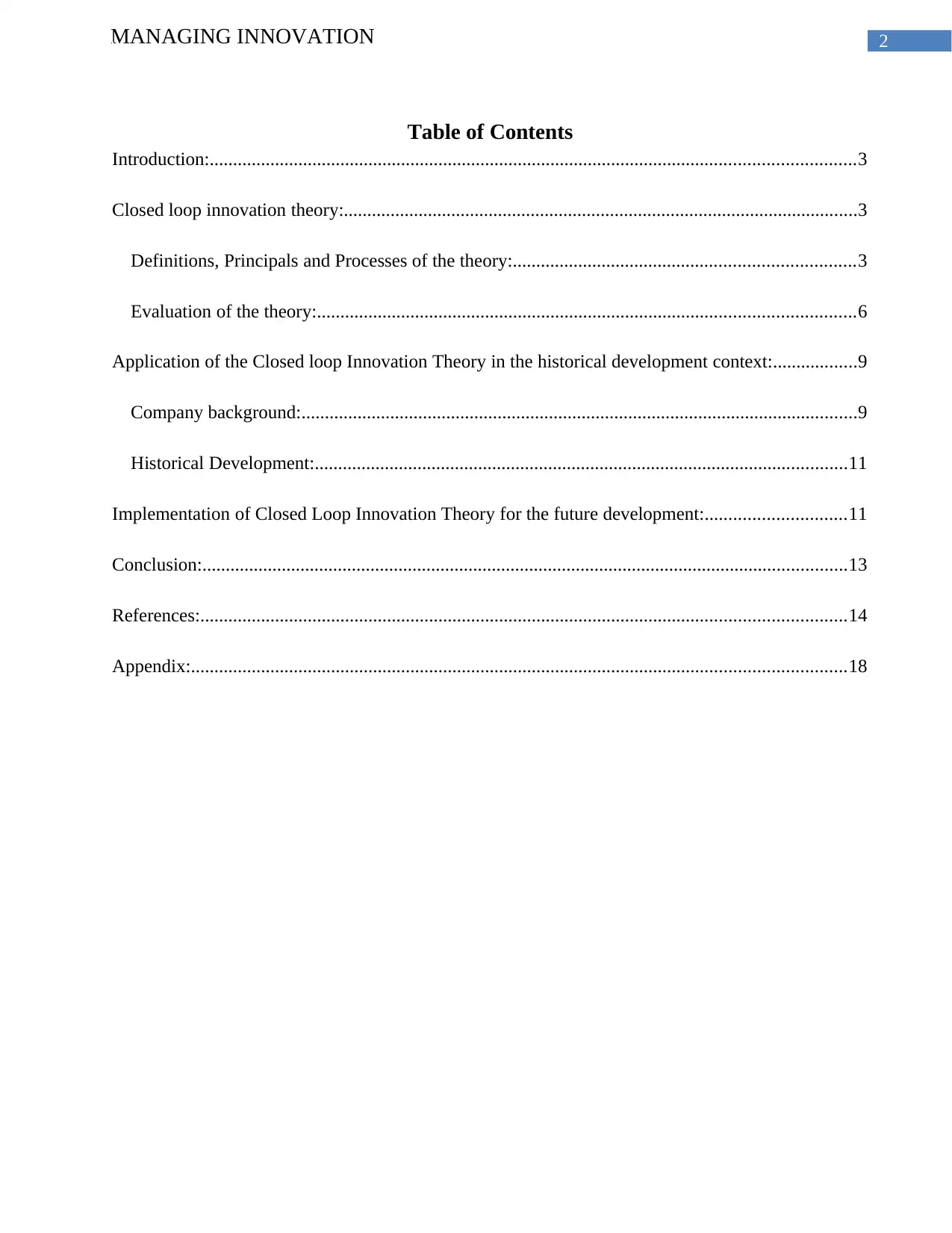
2MANAGING INNOVATION
Table of Contents
Introduction:..........................................................................................................................................3
Closed loop innovation theory:..............................................................................................................3
Definitions, Principals and Processes of the theory:.........................................................................3
Evaluation of the theory:...................................................................................................................6
Application of the Closed loop Innovation Theory in the historical development context:..................9
Company background:.......................................................................................................................9
Historical Development:..................................................................................................................11
Implementation of Closed Loop Innovation Theory for the future development:..............................11
Conclusion:..........................................................................................................................................13
References:..........................................................................................................................................14
Appendix:............................................................................................................................................18
Table of Contents
Introduction:..........................................................................................................................................3
Closed loop innovation theory:..............................................................................................................3
Definitions, Principals and Processes of the theory:.........................................................................3
Evaluation of the theory:...................................................................................................................6
Application of the Closed loop Innovation Theory in the historical development context:..................9
Company background:.......................................................................................................................9
Historical Development:..................................................................................................................11
Implementation of Closed Loop Innovation Theory for the future development:..............................11
Conclusion:..........................................................................................................................................13
References:..........................................................................................................................................14
Appendix:............................................................................................................................................18
⊘ This is a preview!⊘
Do you want full access?
Subscribe today to unlock all pages.

Trusted by 1+ million students worldwide
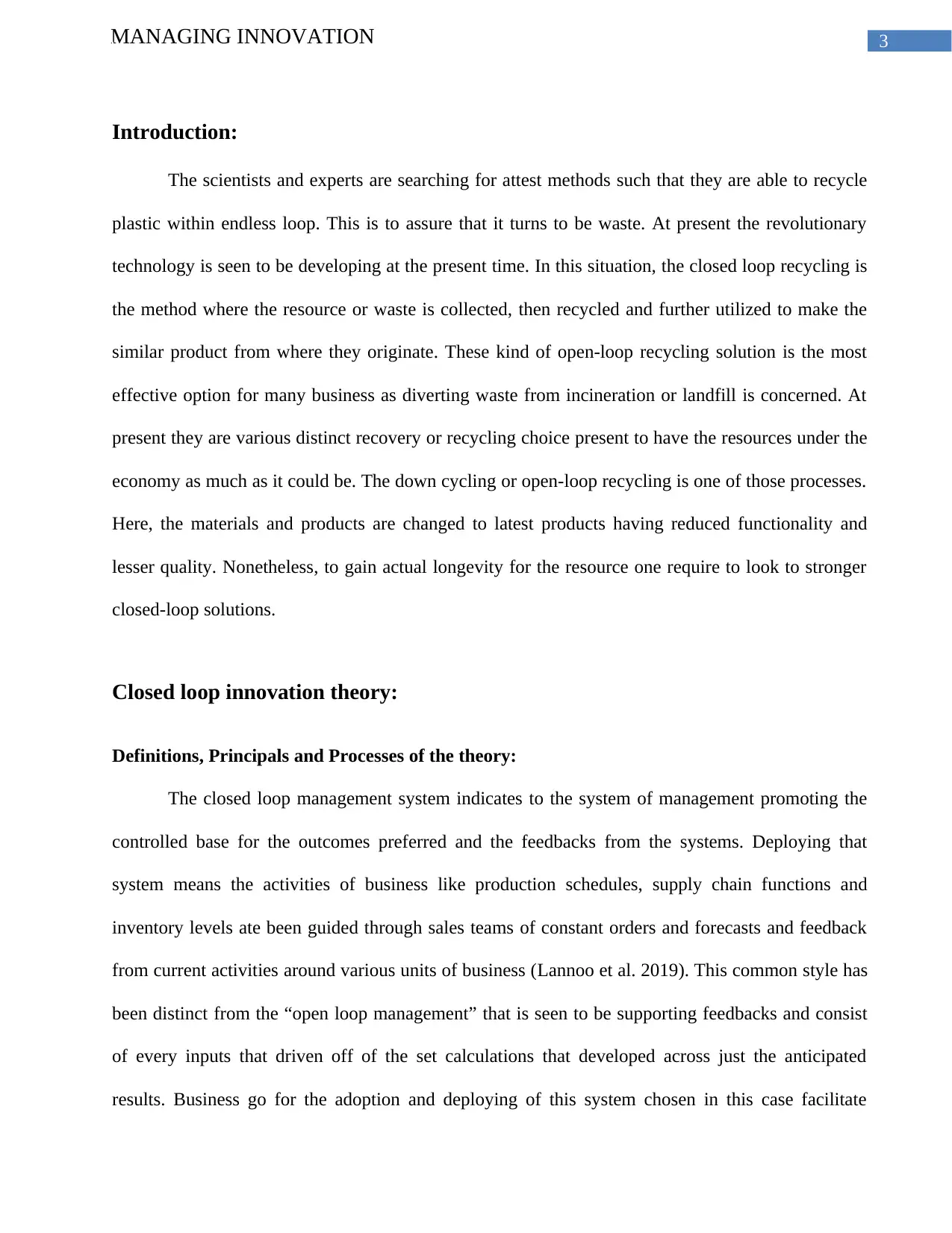
3MANAGING INNOVATION
Introduction:
The scientists and experts are searching for attest methods such that they are able to recycle
plastic within endless loop. This is to assure that it turns to be waste. At present the revolutionary
technology is seen to be developing at the present time. In this situation, the closed loop recycling is
the method where the resource or waste is collected, then recycled and further utilized to make the
similar product from where they originate. These kind of open-loop recycling solution is the most
effective option for many business as diverting waste from incineration or landfill is concerned. At
present they are various distinct recovery or recycling choice present to have the resources under the
economy as much as it could be. The down cycling or open-loop recycling is one of those processes.
Here, the materials and products are changed to latest products having reduced functionality and
lesser quality. Nonetheless, to gain actual longevity for the resource one require to look to stronger
closed-loop solutions.
Closed loop innovation theory:
Definitions, Principals and Processes of the theory:
The closed loop management system indicates to the system of management promoting the
controlled base for the outcomes preferred and the feedbacks from the systems. Deploying that
system means the activities of business like production schedules, supply chain functions and
inventory levels ate been guided through sales teams of constant orders and forecasts and feedback
from current activities around various units of business (Lannoo et al. 2019). This common style has
been distinct from the “open loop management” that is seen to be supporting feedbacks and consist
of every inputs that driven off of the set calculations that developed across just the anticipated
results. Business go for the adoption and deploying of this system chosen in this case facilitate
Introduction:
The scientists and experts are searching for attest methods such that they are able to recycle
plastic within endless loop. This is to assure that it turns to be waste. At present the revolutionary
technology is seen to be developing at the present time. In this situation, the closed loop recycling is
the method where the resource or waste is collected, then recycled and further utilized to make the
similar product from where they originate. These kind of open-loop recycling solution is the most
effective option for many business as diverting waste from incineration or landfill is concerned. At
present they are various distinct recovery or recycling choice present to have the resources under the
economy as much as it could be. The down cycling or open-loop recycling is one of those processes.
Here, the materials and products are changed to latest products having reduced functionality and
lesser quality. Nonetheless, to gain actual longevity for the resource one require to look to stronger
closed-loop solutions.
Closed loop innovation theory:
Definitions, Principals and Processes of the theory:
The closed loop management system indicates to the system of management promoting the
controlled base for the outcomes preferred and the feedbacks from the systems. Deploying that
system means the activities of business like production schedules, supply chain functions and
inventory levels ate been guided through sales teams of constant orders and forecasts and feedback
from current activities around various units of business (Lannoo et al. 2019). This common style has
been distinct from the “open loop management” that is seen to be supporting feedbacks and consist
of every inputs that driven off of the set calculations that developed across just the anticipated
results. Business go for the adoption and deploying of this system chosen in this case facilitate
Paraphrase This Document
Need a fresh take? Get an instant paraphrase of this document with our AI Paraphraser
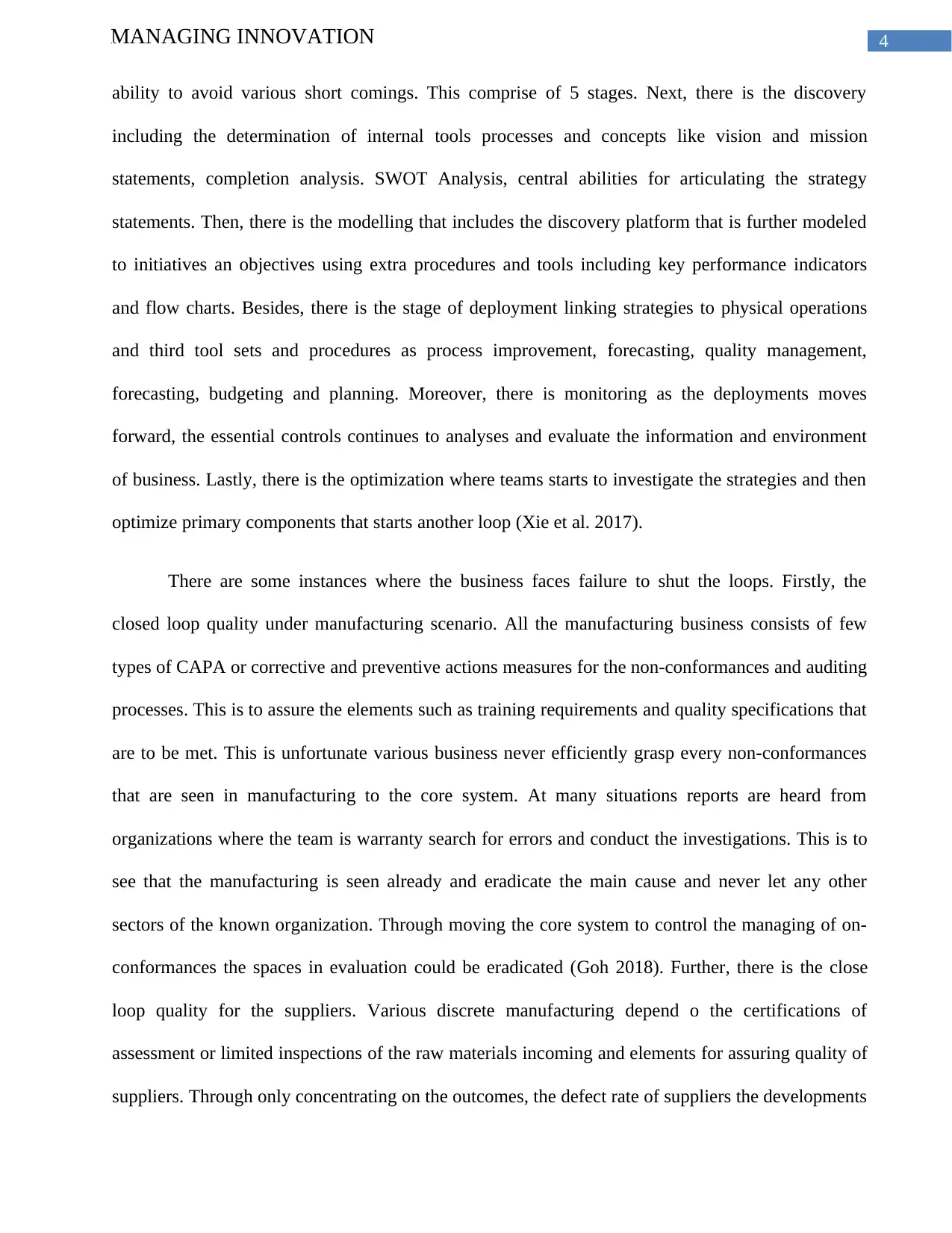
4MANAGING INNOVATION
ability to avoid various short comings. This comprise of 5 stages. Next, there is the discovery
including the determination of internal tools processes and concepts like vision and mission
statements, completion analysis. SWOT Analysis, central abilities for articulating the strategy
statements. Then, there is the modelling that includes the discovery platform that is further modeled
to initiatives an objectives using extra procedures and tools including key performance indicators
and flow charts. Besides, there is the stage of deployment linking strategies to physical operations
and third tool sets and procedures as process improvement, forecasting, quality management,
forecasting, budgeting and planning. Moreover, there is monitoring as the deployments moves
forward, the essential controls continues to analyses and evaluate the information and environment
of business. Lastly, there is the optimization where teams starts to investigate the strategies and then
optimize primary components that starts another loop (Xie et al. 2017).
There are some instances where the business faces failure to shut the loops. Firstly, the
closed loop quality under manufacturing scenario. All the manufacturing business consists of few
types of CAPA or corrective and preventive actions measures for the non-conformances and auditing
processes. This is to assure the elements such as training requirements and quality specifications that
are to be met. This is unfortunate various business never efficiently grasp every non-conformances
that are seen in manufacturing to the core system. At many situations reports are heard from
organizations where the team is warranty search for errors and conduct the investigations. This is to
see that the manufacturing is seen already and eradicate the main cause and never let any other
sectors of the known organization. Through moving the core system to control the managing of on-
conformances the spaces in evaluation could be eradicated (Goh 2018). Further, there is the close
loop quality for the suppliers. Various discrete manufacturing depend o the certifications of
assessment or limited inspections of the raw materials incoming and elements for assuring quality of
suppliers. Through only concentrating on the outcomes, the defect rate of suppliers the developments
ability to avoid various short comings. This comprise of 5 stages. Next, there is the discovery
including the determination of internal tools processes and concepts like vision and mission
statements, completion analysis. SWOT Analysis, central abilities for articulating the strategy
statements. Then, there is the modelling that includes the discovery platform that is further modeled
to initiatives an objectives using extra procedures and tools including key performance indicators
and flow charts. Besides, there is the stage of deployment linking strategies to physical operations
and third tool sets and procedures as process improvement, forecasting, quality management,
forecasting, budgeting and planning. Moreover, there is monitoring as the deployments moves
forward, the essential controls continues to analyses and evaluate the information and environment
of business. Lastly, there is the optimization where teams starts to investigate the strategies and then
optimize primary components that starts another loop (Xie et al. 2017).
There are some instances where the business faces failure to shut the loops. Firstly, the
closed loop quality under manufacturing scenario. All the manufacturing business consists of few
types of CAPA or corrective and preventive actions measures for the non-conformances and auditing
processes. This is to assure the elements such as training requirements and quality specifications that
are to be met. This is unfortunate various business never efficiently grasp every non-conformances
that are seen in manufacturing to the core system. At many situations reports are heard from
organizations where the team is warranty search for errors and conduct the investigations. This is to
see that the manufacturing is seen already and eradicate the main cause and never let any other
sectors of the known organization. Through moving the core system to control the managing of on-
conformances the spaces in evaluation could be eradicated (Goh 2018). Further, there is the close
loop quality for the suppliers. Various discrete manufacturing depend o the certifications of
assessment or limited inspections of the raw materials incoming and elements for assuring quality of
suppliers. Through only concentrating on the outcomes, the defect rate of suppliers the developments
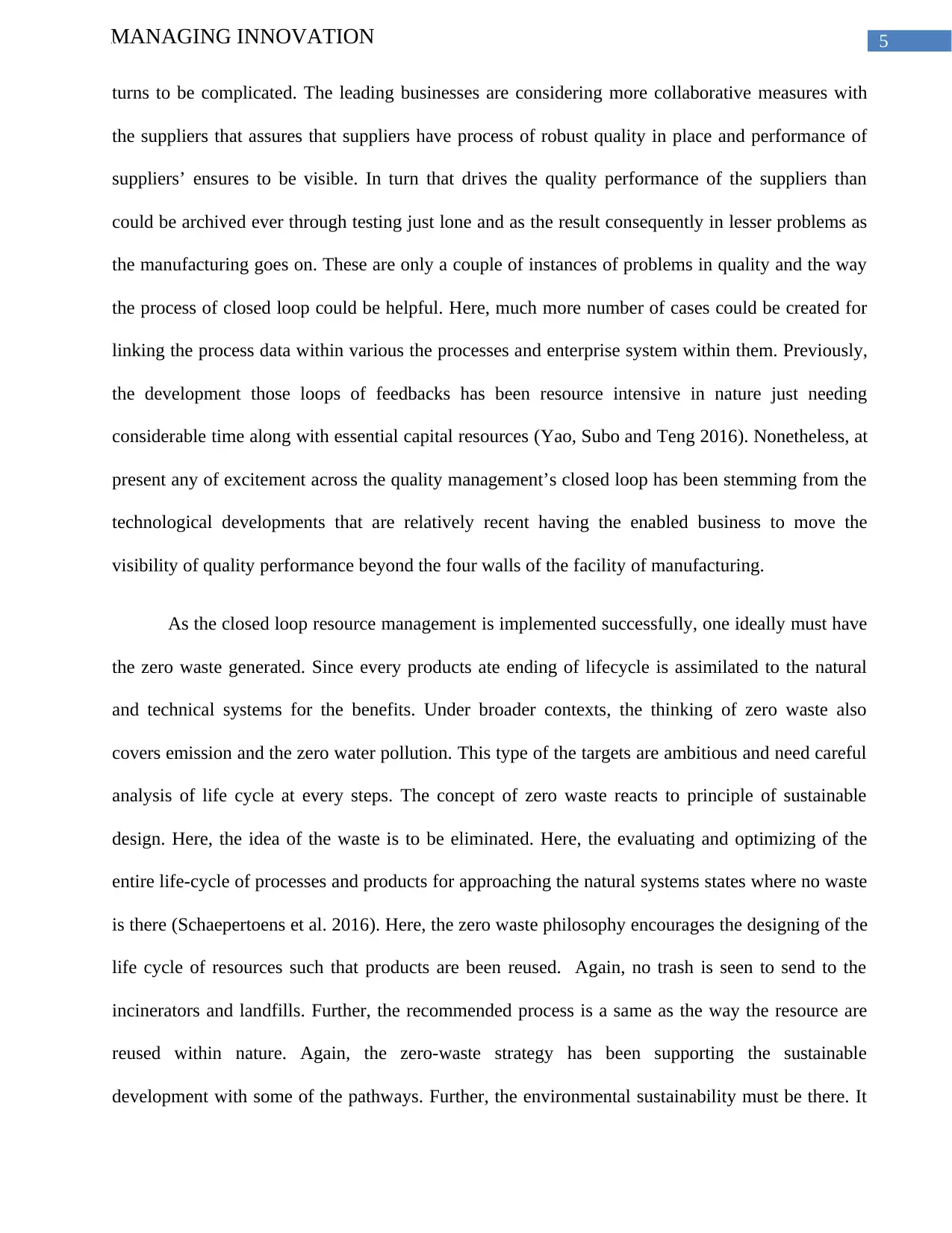
5MANAGING INNOVATION
turns to be complicated. The leading businesses are considering more collaborative measures with
the suppliers that assures that suppliers have process of robust quality in place and performance of
suppliers’ ensures to be visible. In turn that drives the quality performance of the suppliers than
could be archived ever through testing just lone and as the result consequently in lesser problems as
the manufacturing goes on. These are only a couple of instances of problems in quality and the way
the process of closed loop could be helpful. Here, much more number of cases could be created for
linking the process data within various the processes and enterprise system within them. Previously,
the development those loops of feedbacks has been resource intensive in nature just needing
considerable time along with essential capital resources (Yao, Subo and Teng 2016). Nonetheless, at
present any of excitement across the quality management’s closed loop has been stemming from the
technological developments that are relatively recent having the enabled business to move the
visibility of quality performance beyond the four walls of the facility of manufacturing.
As the closed loop resource management is implemented successfully, one ideally must have
the zero waste generated. Since every products ate ending of lifecycle is assimilated to the natural
and technical systems for the benefits. Under broader contexts, the thinking of zero waste also
covers emission and the zero water pollution. This type of the targets are ambitious and need careful
analysis of life cycle at every steps. The concept of zero waste reacts to principle of sustainable
design. Here, the idea of the waste is to be eliminated. Here, the evaluating and optimizing of the
entire life-cycle of processes and products for approaching the natural systems states where no waste
is there (Schaepertoens et al. 2016). Here, the zero waste philosophy encourages the designing of the
life cycle of resources such that products are been reused. Again, no trash is seen to send to the
incinerators and landfills. Further, the recommended process is a same as the way the resource are
reused within nature. Again, the zero-waste strategy has been supporting the sustainable
development with some of the pathways. Further, the environmental sustainability must be there. It
turns to be complicated. The leading businesses are considering more collaborative measures with
the suppliers that assures that suppliers have process of robust quality in place and performance of
suppliers’ ensures to be visible. In turn that drives the quality performance of the suppliers than
could be archived ever through testing just lone and as the result consequently in lesser problems as
the manufacturing goes on. These are only a couple of instances of problems in quality and the way
the process of closed loop could be helpful. Here, much more number of cases could be created for
linking the process data within various the processes and enterprise system within them. Previously,
the development those loops of feedbacks has been resource intensive in nature just needing
considerable time along with essential capital resources (Yao, Subo and Teng 2016). Nonetheless, at
present any of excitement across the quality management’s closed loop has been stemming from the
technological developments that are relatively recent having the enabled business to move the
visibility of quality performance beyond the four walls of the facility of manufacturing.
As the closed loop resource management is implemented successfully, one ideally must have
the zero waste generated. Since every products ate ending of lifecycle is assimilated to the natural
and technical systems for the benefits. Under broader contexts, the thinking of zero waste also
covers emission and the zero water pollution. This type of the targets are ambitious and need careful
analysis of life cycle at every steps. The concept of zero waste reacts to principle of sustainable
design. Here, the idea of the waste is to be eliminated. Here, the evaluating and optimizing of the
entire life-cycle of processes and products for approaching the natural systems states where no waste
is there (Schaepertoens et al. 2016). Here, the zero waste philosophy encourages the designing of the
life cycle of resources such that products are been reused. Again, no trash is seen to send to the
incinerators and landfills. Further, the recommended process is a same as the way the resource are
reused within nature. Again, the zero-waste strategy has been supporting the sustainable
development with some of the pathways. Further, the environmental sustainability must be there. It
⊘ This is a preview!⊘
Do you want full access?
Subscribe today to unlock all pages.

Trusted by 1+ million students worldwide
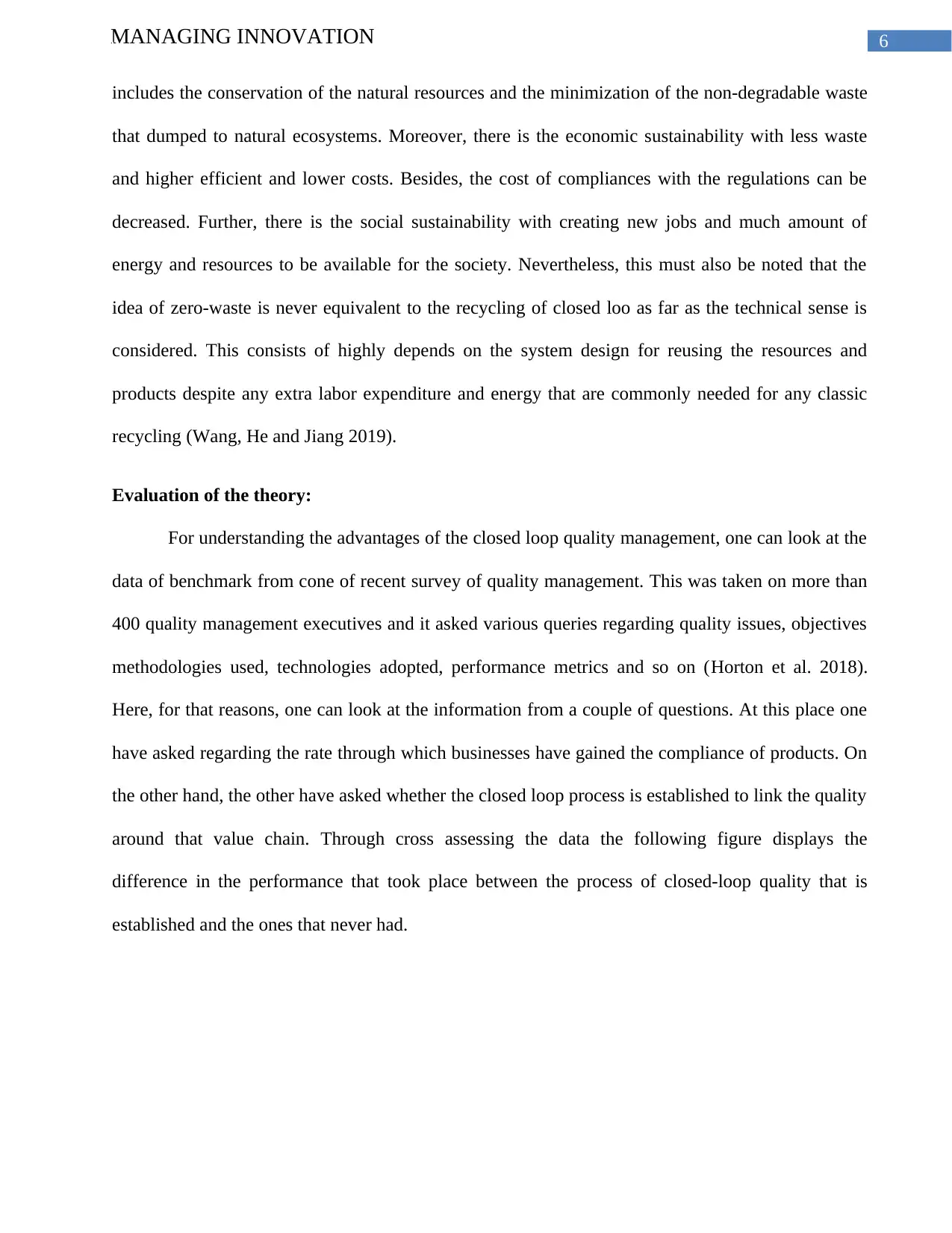
6MANAGING INNOVATION
includes the conservation of the natural resources and the minimization of the non-degradable waste
that dumped to natural ecosystems. Moreover, there is the economic sustainability with less waste
and higher efficient and lower costs. Besides, the cost of compliances with the regulations can be
decreased. Further, there is the social sustainability with creating new jobs and much amount of
energy and resources to be available for the society. Nevertheless, this must also be noted that the
idea of zero-waste is never equivalent to the recycling of closed loo as far as the technical sense is
considered. This consists of highly depends on the system design for reusing the resources and
products despite any extra labor expenditure and energy that are commonly needed for any classic
recycling (Wang, He and Jiang 2019).
Evaluation of the theory:
For understanding the advantages of the closed loop quality management, one can look at the
data of benchmark from cone of recent survey of quality management. This was taken on more than
400 quality management executives and it asked various queries regarding quality issues, objectives
methodologies used, technologies adopted, performance metrics and so on (Horton et al. 2018).
Here, for that reasons, one can look at the information from a couple of questions. At this place one
have asked regarding the rate through which businesses have gained the compliance of products. On
the other hand, the other have asked whether the closed loop process is established to link the quality
around that value chain. Through cross assessing the data the following figure displays the
difference in the performance that took place between the process of closed-loop quality that is
established and the ones that never had.
includes the conservation of the natural resources and the minimization of the non-degradable waste
that dumped to natural ecosystems. Moreover, there is the economic sustainability with less waste
and higher efficient and lower costs. Besides, the cost of compliances with the regulations can be
decreased. Further, there is the social sustainability with creating new jobs and much amount of
energy and resources to be available for the society. Nevertheless, this must also be noted that the
idea of zero-waste is never equivalent to the recycling of closed loo as far as the technical sense is
considered. This consists of highly depends on the system design for reusing the resources and
products despite any extra labor expenditure and energy that are commonly needed for any classic
recycling (Wang, He and Jiang 2019).
Evaluation of the theory:
For understanding the advantages of the closed loop quality management, one can look at the
data of benchmark from cone of recent survey of quality management. This was taken on more than
400 quality management executives and it asked various queries regarding quality issues, objectives
methodologies used, technologies adopted, performance metrics and so on (Horton et al. 2018).
Here, for that reasons, one can look at the information from a couple of questions. At this place one
have asked regarding the rate through which businesses have gained the compliance of products. On
the other hand, the other have asked whether the closed loop process is established to link the quality
around that value chain. Through cross assessing the data the following figure displays the
difference in the performance that took place between the process of closed-loop quality that is
established and the ones that never had.
Paraphrase This Document
Need a fresh take? Get an instant paraphrase of this document with our AI Paraphraser
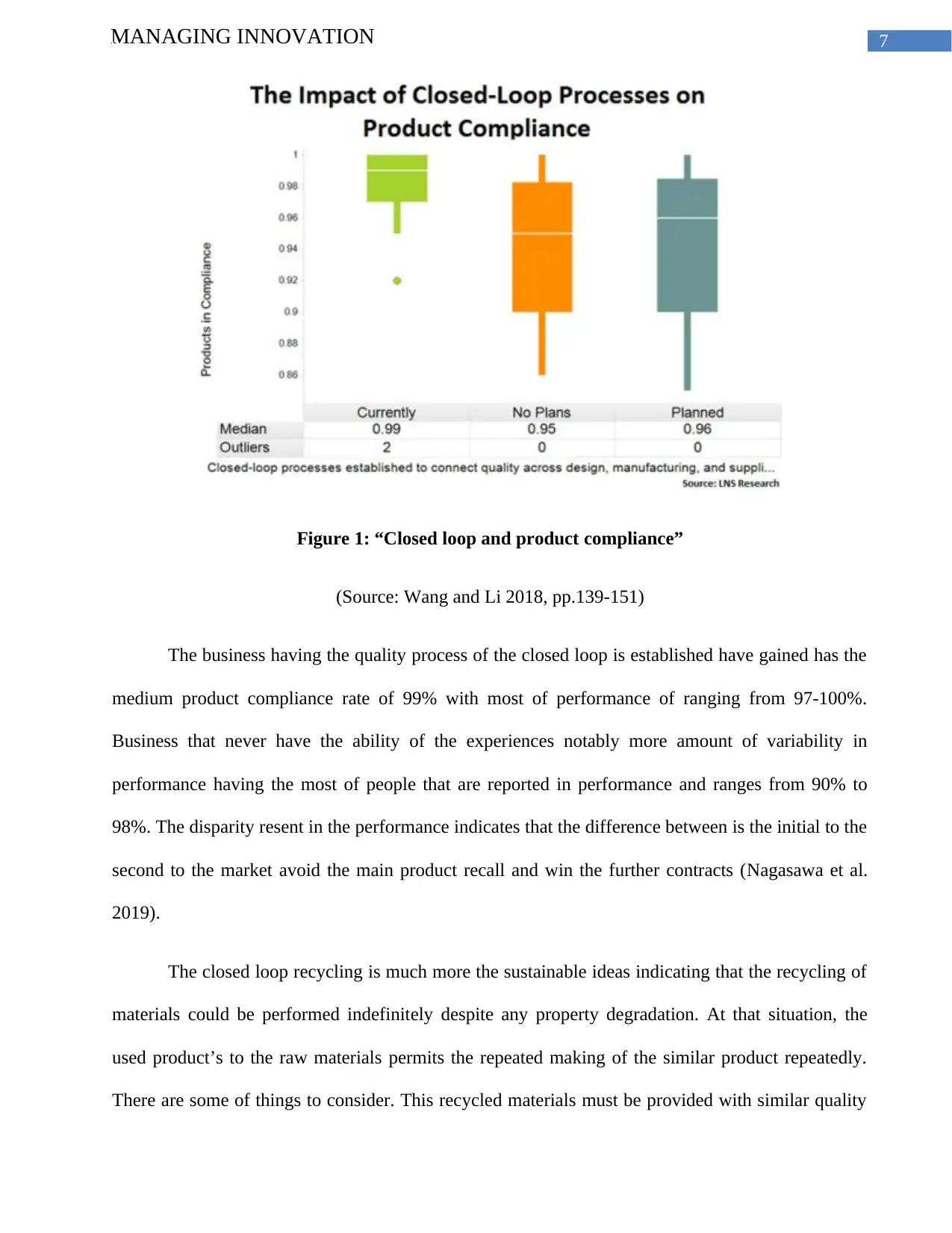
7MANAGING INNOVATION
Figure 1: “Closed loop and product compliance”
(Source: Wang and Li 2018, pp.139-151)
The business having the quality process of the closed loop is established have gained has the
medium product compliance rate of 99% with most of performance of ranging from 97-100%.
Business that never have the ability of the experiences notably more amount of variability in
performance having the most of people that are reported in performance and ranges from 90% to
98%. The disparity resent in the performance indicates that the difference between is the initial to the
second to the market avoid the main product recall and win the further contracts (Nagasawa et al.
2019).
The closed loop recycling is much more the sustainable ideas indicating that the recycling of
materials could be performed indefinitely despite any property degradation. At that situation, the
used product’s to the raw materials permits the repeated making of the similar product repeatedly.
There are some of things to consider. This recycled materials must be provided with similar quality
Figure 1: “Closed loop and product compliance”
(Source: Wang and Li 2018, pp.139-151)
The business having the quality process of the closed loop is established have gained has the
medium product compliance rate of 99% with most of performance of ranging from 97-100%.
Business that never have the ability of the experiences notably more amount of variability in
performance having the most of people that are reported in performance and ranges from 90% to
98%. The disparity resent in the performance indicates that the difference between is the initial to the
second to the market avoid the main product recall and win the further contracts (Nagasawa et al.
2019).
The closed loop recycling is much more the sustainable ideas indicating that the recycling of
materials could be performed indefinitely despite any property degradation. At that situation, the
used product’s to the raw materials permits the repeated making of the similar product repeatedly.
There are some of things to consider. This recycled materials must be provided with similar quality
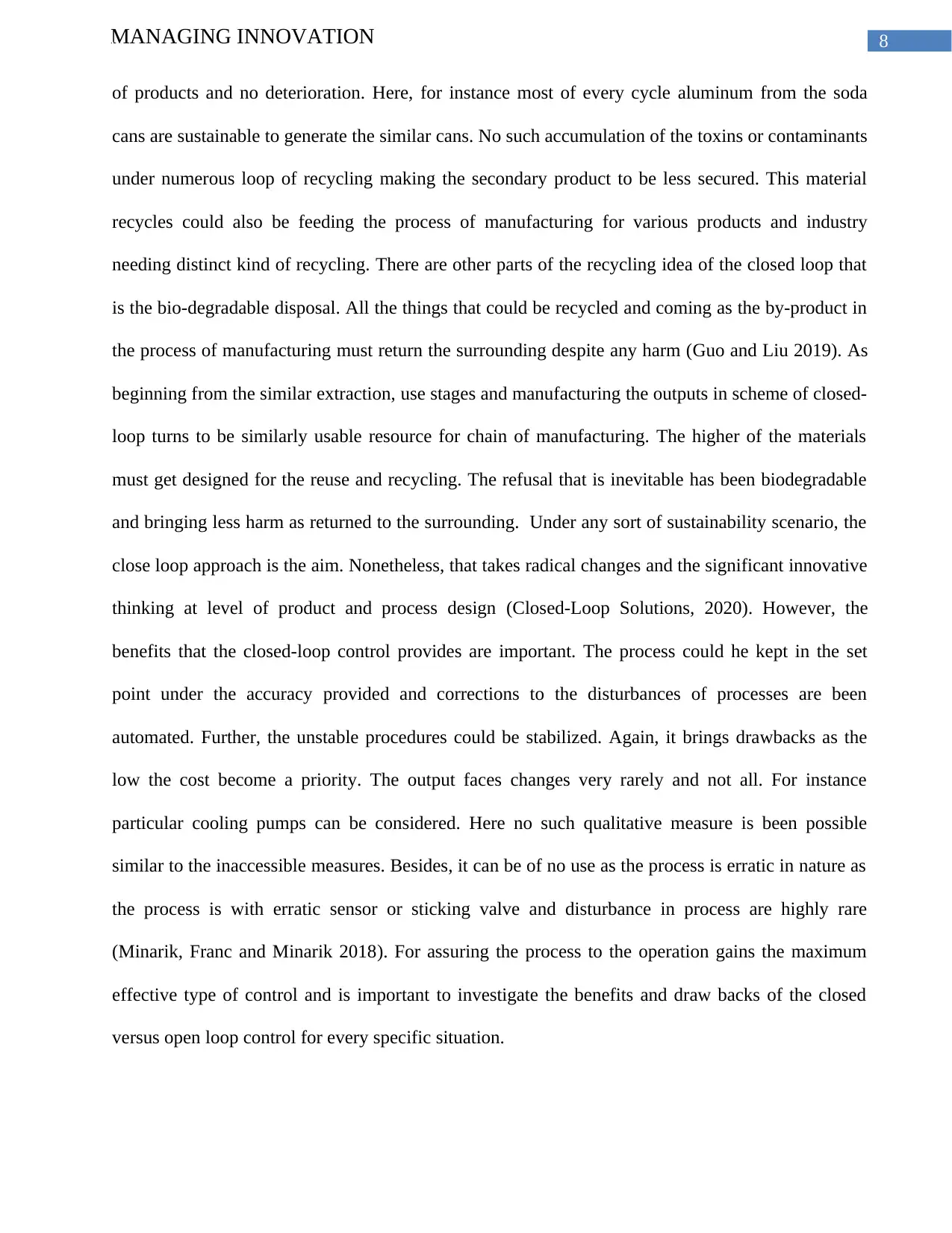
8MANAGING INNOVATION
of products and no deterioration. Here, for instance most of every cycle aluminum from the soda
cans are sustainable to generate the similar cans. No such accumulation of the toxins or contaminants
under numerous loop of recycling making the secondary product to be less secured. This material
recycles could also be feeding the process of manufacturing for various products and industry
needing distinct kind of recycling. There are other parts of the recycling idea of the closed loop that
is the bio-degradable disposal. All the things that could be recycled and coming as the by-product in
the process of manufacturing must return the surrounding despite any harm (Guo and Liu 2019). As
beginning from the similar extraction, use stages and manufacturing the outputs in scheme of closed-
loop turns to be similarly usable resource for chain of manufacturing. The higher of the materials
must get designed for the reuse and recycling. The refusal that is inevitable has been biodegradable
and bringing less harm as returned to the surrounding. Under any sort of sustainability scenario, the
close loop approach is the aim. Nonetheless, that takes radical changes and the significant innovative
thinking at level of product and process design (Closed-Loop Solutions, 2020). However, the
benefits that the closed-loop control provides are important. The process could he kept in the set
point under the accuracy provided and corrections to the disturbances of processes are been
automated. Further, the unstable procedures could be stabilized. Again, it brings drawbacks as the
low the cost become a priority. The output faces changes very rarely and not all. For instance
particular cooling pumps can be considered. Here no such qualitative measure is been possible
similar to the inaccessible measures. Besides, it can be of no use as the process is erratic in nature as
the process is with erratic sensor or sticking valve and disturbance in process are highly rare
(Minarik, Franc and Minarik 2018). For assuring the process to the operation gains the maximum
effective type of control and is important to investigate the benefits and draw backs of the closed
versus open loop control for every specific situation.
of products and no deterioration. Here, for instance most of every cycle aluminum from the soda
cans are sustainable to generate the similar cans. No such accumulation of the toxins or contaminants
under numerous loop of recycling making the secondary product to be less secured. This material
recycles could also be feeding the process of manufacturing for various products and industry
needing distinct kind of recycling. There are other parts of the recycling idea of the closed loop that
is the bio-degradable disposal. All the things that could be recycled and coming as the by-product in
the process of manufacturing must return the surrounding despite any harm (Guo and Liu 2019). As
beginning from the similar extraction, use stages and manufacturing the outputs in scheme of closed-
loop turns to be similarly usable resource for chain of manufacturing. The higher of the materials
must get designed for the reuse and recycling. The refusal that is inevitable has been biodegradable
and bringing less harm as returned to the surrounding. Under any sort of sustainability scenario, the
close loop approach is the aim. Nonetheless, that takes radical changes and the significant innovative
thinking at level of product and process design (Closed-Loop Solutions, 2020). However, the
benefits that the closed-loop control provides are important. The process could he kept in the set
point under the accuracy provided and corrections to the disturbances of processes are been
automated. Further, the unstable procedures could be stabilized. Again, it brings drawbacks as the
low the cost become a priority. The output faces changes very rarely and not all. For instance
particular cooling pumps can be considered. Here no such qualitative measure is been possible
similar to the inaccessible measures. Besides, it can be of no use as the process is erratic in nature as
the process is with erratic sensor or sticking valve and disturbance in process are highly rare
(Minarik, Franc and Minarik 2018). For assuring the process to the operation gains the maximum
effective type of control and is important to investigate the benefits and draw backs of the closed
versus open loop control for every specific situation.
⊘ This is a preview!⊘
Do you want full access?
Subscribe today to unlock all pages.

Trusted by 1+ million students worldwide
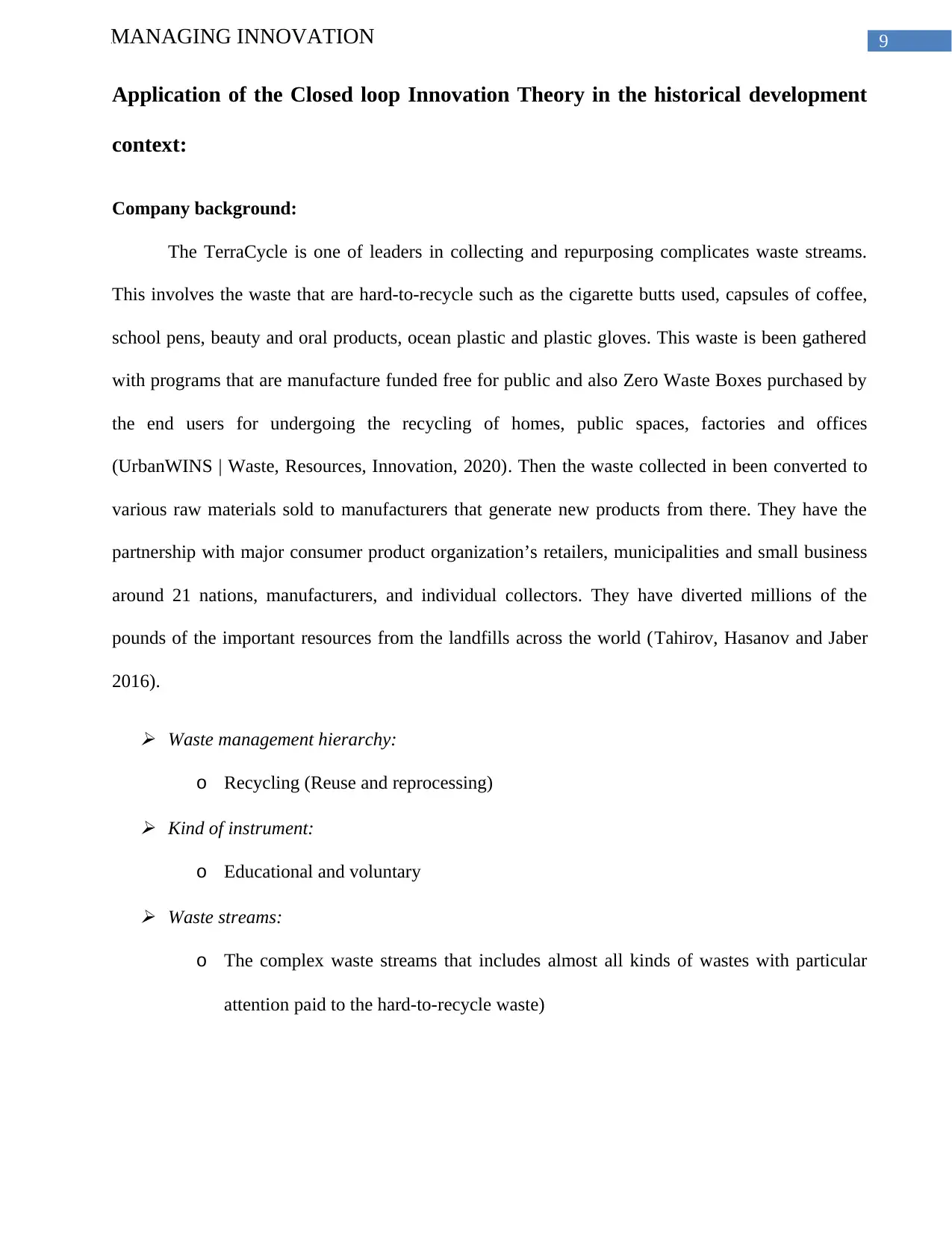
9MANAGING INNOVATION
Application of the Closed loop Innovation Theory in the historical development
context:
Company background:
The TerraCycle is one of leaders in collecting and repurposing complicates waste streams.
This involves the waste that are hard-to-recycle such as the cigarette butts used, capsules of coffee,
school pens, beauty and oral products, ocean plastic and plastic gloves. This waste is been gathered
with programs that are manufacture funded free for public and also Zero Waste Boxes purchased by
the end users for undergoing the recycling of homes, public spaces, factories and offices
(UrbanWINS | Waste, Resources, Innovation, 2020). Then the waste collected in been converted to
various raw materials sold to manufacturers that generate new products from there. They have the
partnership with major consumer product organization’s retailers, municipalities and small business
around 21 nations, manufacturers, and individual collectors. They have diverted millions of the
pounds of the important resources from the landfills across the world (Tahirov, Hasanov and Jaber
2016).
Waste management hierarchy:
o Recycling (Reuse and reprocessing) Kind of instrument:
o Educational and voluntary Waste streams:
o The complex waste streams that includes almost all kinds of wastes with particular
attention paid to the hard-to-recycle waste)
Application of the Closed loop Innovation Theory in the historical development
context:
Company background:
The TerraCycle is one of leaders in collecting and repurposing complicates waste streams.
This involves the waste that are hard-to-recycle such as the cigarette butts used, capsules of coffee,
school pens, beauty and oral products, ocean plastic and plastic gloves. This waste is been gathered
with programs that are manufacture funded free for public and also Zero Waste Boxes purchased by
the end users for undergoing the recycling of homes, public spaces, factories and offices
(UrbanWINS | Waste, Resources, Innovation, 2020). Then the waste collected in been converted to
various raw materials sold to manufacturers that generate new products from there. They have the
partnership with major consumer product organization’s retailers, municipalities and small business
around 21 nations, manufacturers, and individual collectors. They have diverted millions of the
pounds of the important resources from the landfills across the world (Tahirov, Hasanov and Jaber
2016).
Waste management hierarchy:
o Recycling (Reuse and reprocessing) Kind of instrument:
o Educational and voluntary Waste streams:
o The complex waste streams that includes almost all kinds of wastes with particular
attention paid to the hard-to-recycle waste)
Paraphrase This Document
Need a fresh take? Get an instant paraphrase of this document with our AI Paraphraser
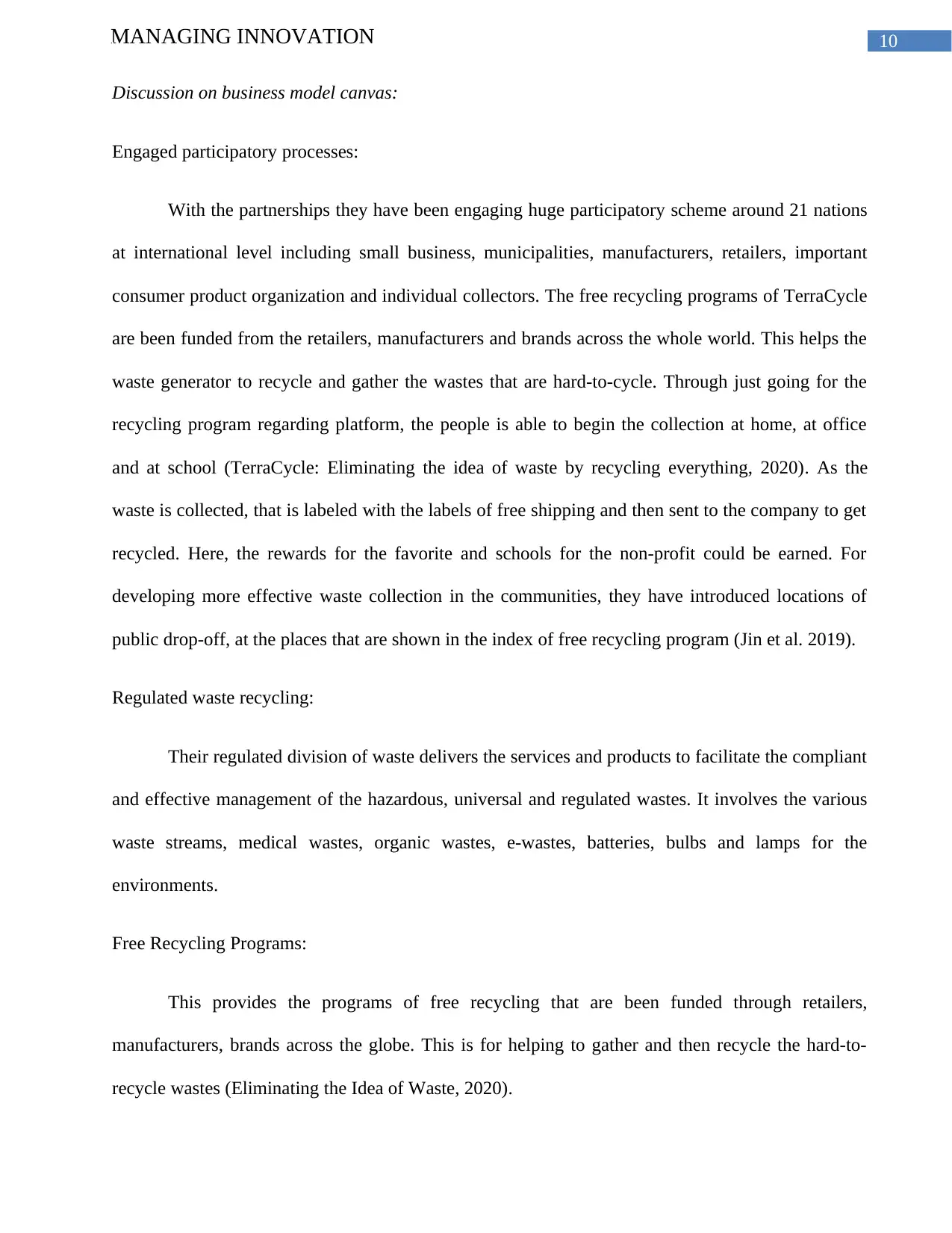
10MANAGING INNOVATION
Discussion on business model canvas:
Engaged participatory processes:
With the partnerships they have been engaging huge participatory scheme around 21 nations
at international level including small business, municipalities, manufacturers, retailers, important
consumer product organization and individual collectors. The free recycling programs of TerraCycle
are been funded from the retailers, manufacturers and brands across the whole world. This helps the
waste generator to recycle and gather the wastes that are hard-to-cycle. Through just going for the
recycling program regarding platform, the people is able to begin the collection at home, at office
and at school (TerraCycle: Eliminating the idea of waste by recycling everything, 2020). As the
waste is collected, that is labeled with the labels of free shipping and then sent to the company to get
recycled. Here, the rewards for the favorite and schools for the non-profit could be earned. For
developing more effective waste collection in the communities, they have introduced locations of
public drop-off, at the places that are shown in the index of free recycling program (Jin et al. 2019).
Regulated waste recycling:
Their regulated division of waste delivers the services and products to facilitate the compliant
and effective management of the hazardous, universal and regulated wastes. It involves the various
waste streams, medical wastes, organic wastes, e-wastes, batteries, bulbs and lamps for the
environments.
Free Recycling Programs:
This provides the programs of free recycling that are been funded through retailers,
manufacturers, brands across the globe. This is for helping to gather and then recycle the hard-to-
recycle wastes (Eliminating the Idea of Waste, 2020).
Discussion on business model canvas:
Engaged participatory processes:
With the partnerships they have been engaging huge participatory scheme around 21 nations
at international level including small business, municipalities, manufacturers, retailers, important
consumer product organization and individual collectors. The free recycling programs of TerraCycle
are been funded from the retailers, manufacturers and brands across the whole world. This helps the
waste generator to recycle and gather the wastes that are hard-to-cycle. Through just going for the
recycling program regarding platform, the people is able to begin the collection at home, at office
and at school (TerraCycle: Eliminating the idea of waste by recycling everything, 2020). As the
waste is collected, that is labeled with the labels of free shipping and then sent to the company to get
recycled. Here, the rewards for the favorite and schools for the non-profit could be earned. For
developing more effective waste collection in the communities, they have introduced locations of
public drop-off, at the places that are shown in the index of free recycling program (Jin et al. 2019).
Regulated waste recycling:
Their regulated division of waste delivers the services and products to facilitate the compliant
and effective management of the hazardous, universal and regulated wastes. It involves the various
waste streams, medical wastes, organic wastes, e-wastes, batteries, bulbs and lamps for the
environments.
Free Recycling Programs:
This provides the programs of free recycling that are been funded through retailers,
manufacturers, brands across the globe. This is for helping to gather and then recycle the hard-to-
recycle wastes (Eliminating the Idea of Waste, 2020).
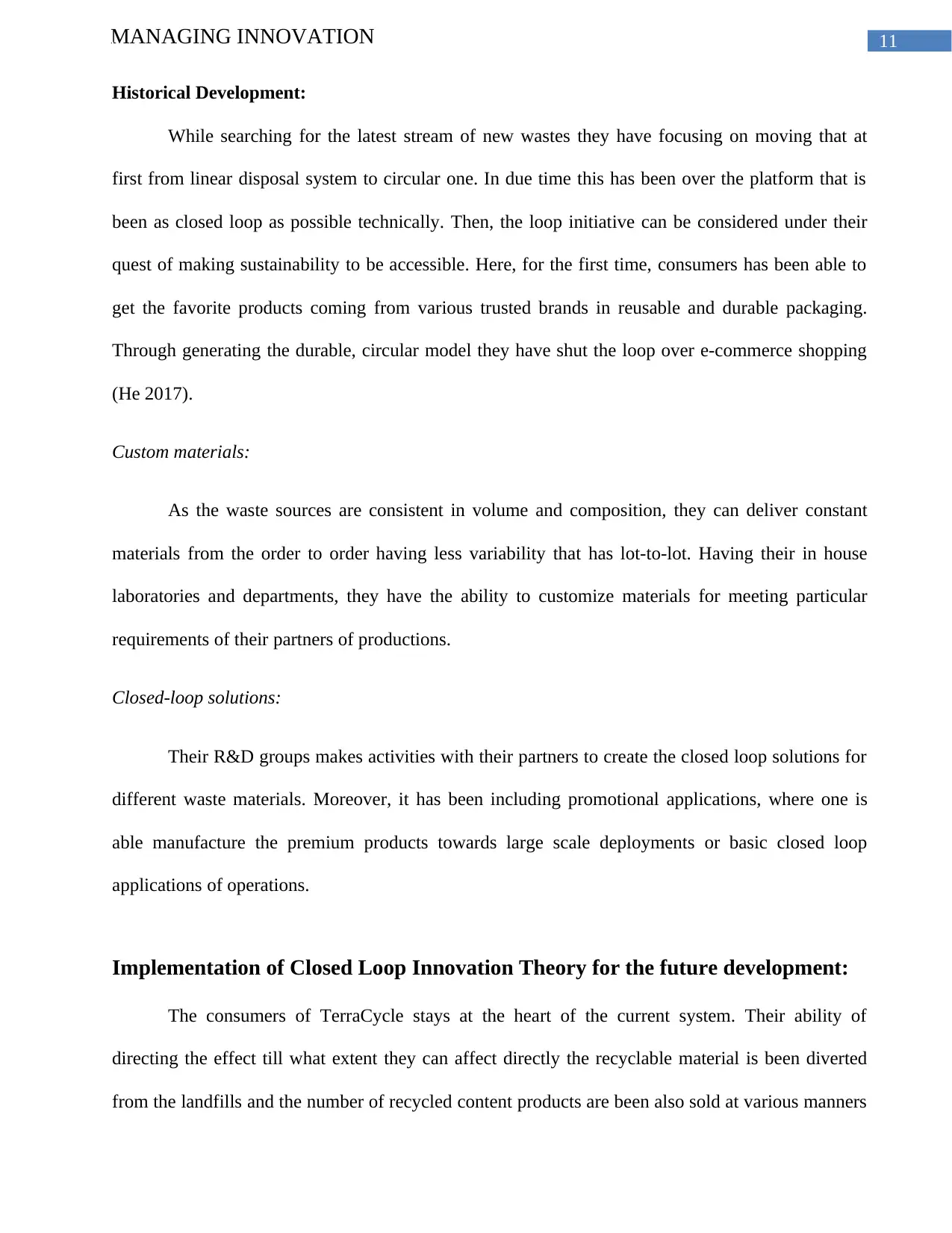
11MANAGING INNOVATION
Historical Development:
While searching for the latest stream of new wastes they have focusing on moving that at
first from linear disposal system to circular one. In due time this has been over the platform that is
been as closed loop as possible technically. Then, the loop initiative can be considered under their
quest of making sustainability to be accessible. Here, for the first time, consumers has been able to
get the favorite products coming from various trusted brands in reusable and durable packaging.
Through generating the durable, circular model they have shut the loop over e-commerce shopping
(He 2017).
Custom materials:
As the waste sources are consistent in volume and composition, they can deliver constant
materials from the order to order having less variability that has lot-to-lot. Having their in house
laboratories and departments, they have the ability to customize materials for meeting particular
requirements of their partners of productions.
Closed-loop solutions:
Their R&D groups makes activities with their partners to create the closed loop solutions for
different waste materials. Moreover, it has been including promotional applications, where one is
able manufacture the premium products towards large scale deployments or basic closed loop
applications of operations.
Implementation of Closed Loop Innovation Theory for the future development:
The consumers of TerraCycle stays at the heart of the current system. Their ability of
directing the effect till what extent they can affect directly the recyclable material is been diverted
from the landfills and the number of recycled content products are been also sold at various manners
Historical Development:
While searching for the latest stream of new wastes they have focusing on moving that at
first from linear disposal system to circular one. In due time this has been over the platform that is
been as closed loop as possible technically. Then, the loop initiative can be considered under their
quest of making sustainability to be accessible. Here, for the first time, consumers has been able to
get the favorite products coming from various trusted brands in reusable and durable packaging.
Through generating the durable, circular model they have shut the loop over e-commerce shopping
(He 2017).
Custom materials:
As the waste sources are consistent in volume and composition, they can deliver constant
materials from the order to order having less variability that has lot-to-lot. Having their in house
laboratories and departments, they have the ability to customize materials for meeting particular
requirements of their partners of productions.
Closed-loop solutions:
Their R&D groups makes activities with their partners to create the closed loop solutions for
different waste materials. Moreover, it has been including promotional applications, where one is
able manufacture the premium products towards large scale deployments or basic closed loop
applications of operations.
Implementation of Closed Loop Innovation Theory for the future development:
The consumers of TerraCycle stays at the heart of the current system. Their ability of
directing the effect till what extent they can affect directly the recyclable material is been diverted
from the landfills and the number of recycled content products are been also sold at various manners
⊘ This is a preview!⊘
Do you want full access?
Subscribe today to unlock all pages.

Trusted by 1+ million students worldwide
1 out of 22
Related Documents
Your All-in-One AI-Powered Toolkit for Academic Success.
+13062052269
info@desklib.com
Available 24*7 on WhatsApp / Email
![[object Object]](/_next/static/media/star-bottom.7253800d.svg)
Unlock your academic potential
Copyright © 2020–2025 A2Z Services. All Rights Reserved. Developed and managed by ZUCOL.





